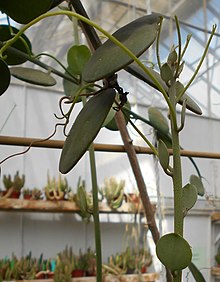Xerosicyos: Difference between revisions
Content deleted Content added
m Task 3: +{{Taxonbar|from=Q2584092}} (5 sig. taxon IDs); WP:GenFixes using AWB |
added Category:Cucurbitaceae using HotCat; automatic taxobox |
||
| Line 1: | Line 1: | ||
{{Unreferenced|type=plant|date=December 2009}} |
{{Unreferenced|type=plant|date=December 2009}} |
||
{{taxobox |
{{Automatic taxobox |
||
|image = Xerosicyos danguyi 2015-05-29 OB 187.jpg |
|image = Xerosicyos danguyi 2015-05-29 OB 187.jpg |
||
|image_caption = Silver dollar plant (''Xerosicyos danguyi'') |
|image_caption = Silver dollar plant (''Xerosicyos danguyi'') |
||
| ⚫ | |||
|regnum = [[Plant]]ae |
|||
| ⚫ | |||
|unranked_divisio = [[Angiosperms]] |
|||
| ⚫ | |||
|unranked_classis = [[Eudicots]] |
|||
| ⚫ | |||
|unranked_ordo = [[Rosids]] |
|||
|ordo = [[Cucurbitales]] |
|||
| ⚫ | |||
|subfamilia = [[Zanonioideae]] |
|||
|tribus = [[Zanonieae]] |
|||
|subtribus = [[Zanoniinae]] |
|||
| ⚫ | |||
| ⚫ | |||
| ⚫ | |||
| ⚫ | |||
''[[Xerosicyos perrieri]]''<br> |
''[[Xerosicyos perrieri]]''<br> |
||
''[[Xerosicyos pubescens]]'' |
''[[Xerosicyos pubescens]]'' |
||
}} |
|||
'''''Xerosicyos''''' is a [[angiosperms|flowering plant]] [[genus]] of the [[family (biology)|family]] [[Cucurbitaceae]]. Its name comes from [[Greek language|Greek]] ''xeros'' (meaning "dry") and ''sicyos'' ("cucumber"). There are three species, all endemic to Madagascar. ''Xerosicyos danguyi'' is a large [[liana]] with thick stems and round, gray succulent leaves. It is common in cultivation and often called the " |
'''''Xerosicyos''''' is a [[angiosperms|flowering plant]] [[genus]] of the [[family (biology)|family]] [[Cucurbitaceae]]. Its name comes from [[Greek language|Greek]] ''xeros'' (meaning "dry") and ''sicyos'' ("cucumber"). There are three species, all endemic to Madagascar. ''Xerosicyos danguyi'' is a large [[liana]] with thick stems and round, gray succulent leaves. It is common in cultivation and often called the "silver dollar" vine. ''Xerosicyos perrieri'' is also a liana with thinner stems and smaller, ovate green succulent leaves. ''Xerosicyos pubescens'' is entirely different from the previous species. It forms a large caudex from which deciduous vines emerge. The leaves are lobed and semi-succulent and die back in the dry season and during prolonged periods of drought. |
||
== References == |
== References == |
||
| Line 28: | Line 19: | ||
[[Category:Cucurbitaceae genera]] |
[[Category:Cucurbitaceae genera]] |
||
| ⚫ | |||
Revision as of 19:25, 22 June 2018
| Xerosicyos | |
|---|---|

| |
| Silver dollar plant (Xerosicyos danguyi) | |
| Scientific classification | |
| Kingdom: | Plantae |
| Clade: | Tracheophytes |
| Clade: | Angiosperms |
| Clade: | Eudicots |
| Clade: | Rosids |
| Order: | Cucurbitales |
| Family: | Cucurbitaceae |
| Tribe: | Zanonieae |
| Genus: | Xerosicyos Humbert |
| Species | |
Xerosicyos is a flowering plant genus of the family Cucurbitaceae. Its name comes from Greek xeros (meaning "dry") and sicyos ("cucumber"). There are three species, all endemic to Madagascar. Xerosicyos danguyi is a large liana with thick stems and round, gray succulent leaves. It is common in cultivation and often called the "silver dollar" vine. Xerosicyos perrieri is also a liana with thinner stems and smaller, ovate green succulent leaves. Xerosicyos pubescens is entirely different from the previous species. It forms a large caudex from which deciduous vines emerge. The leaves are lobed and semi-succulent and die back in the dry season and during prolonged periods of drought.
References
